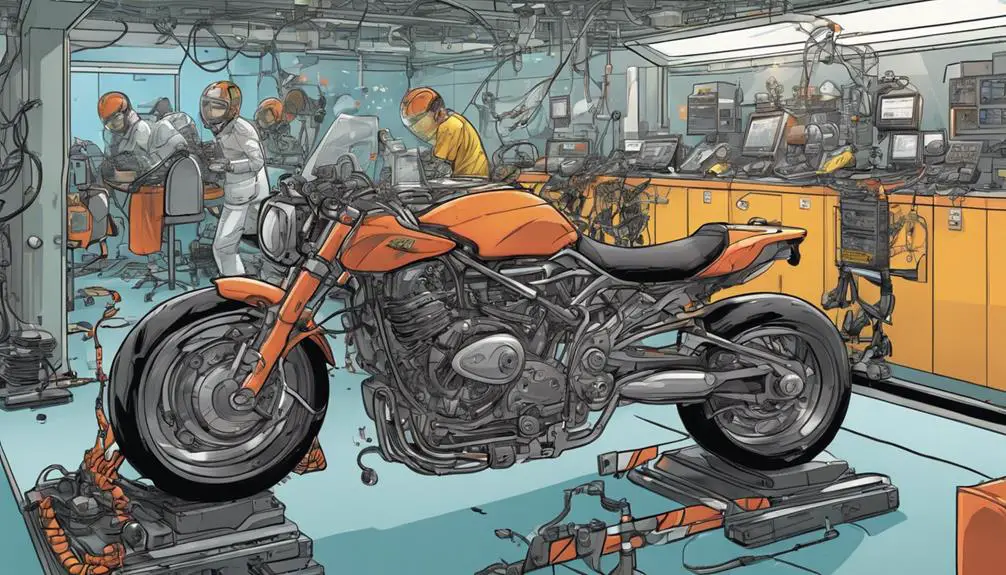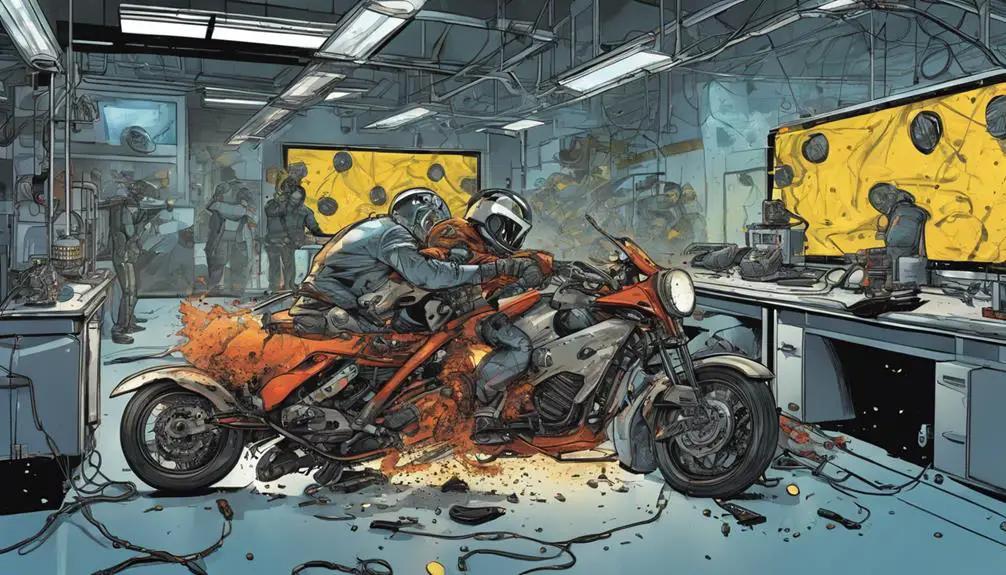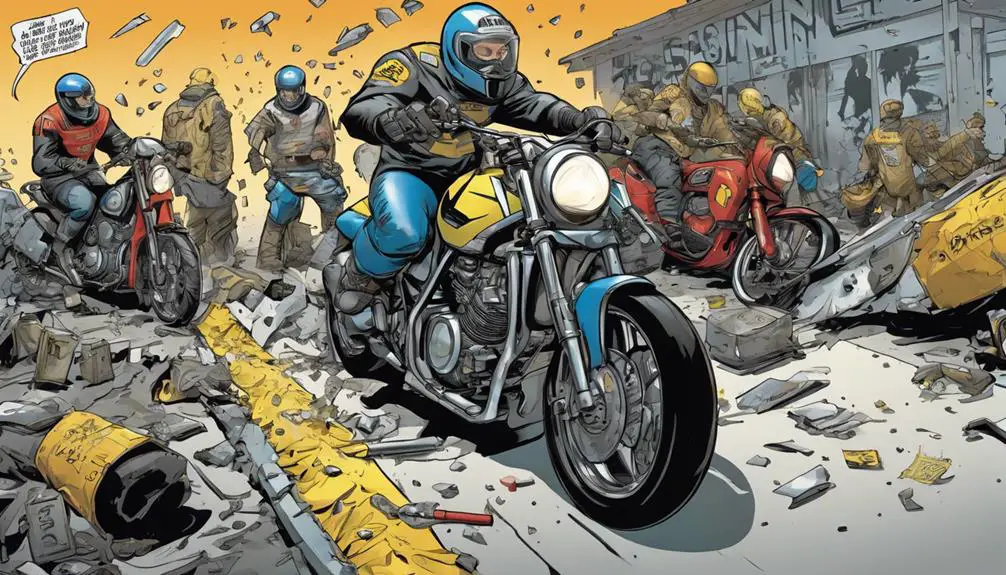Imagine you're considering a new motorcycle and come across crash test results that indicate a model you like performed poorly in safety evaluations. These results are more than just numbers; they can greatly influence your safety on the road. By understanding how these ratings reflect a motorcycle's ability to protect you in an accident, you can make better choices. But what specific factors contribute to these ratings, and how can they impact the overall riding experience?
Quick Takeaways
- Motorcycle crash test results provide vital information on safety performance, influencing rider choices and overall confidence.
- High ratings indicate better shock absorption and lower injury risk during accidents, promoting safer riding experiences.
- Manufacturers use crash test outcomes to enhance designs and safety features, leading to continuous improvements in motorcycle safety.
- Knowledge of crash test ratings fosters advocacy for improved safety standards and increased awareness among riders.
Understanding Crash Test Ratings

When you look at crash test ratings, you're gaining essential insights into a motorcycle's safety performance in real-world scenarios. These ratings reveal how well a bike can withstand impacts and protect you during an accident. You want to feel liberated when riding, and understanding these ratings helps you make informed choices about your safety.
Crash test ratings are typically conducted by independent organizations, which evaluate various factors like structural integrity, crashworthiness, and rider protection features. The results are often displayed as star ratings or scores, making it easier for you to compare different models.
A higher rating indicates a motorcycle that better absorbs shock and minimizes injury risk, granting you confidence on the open road.
Suzuki Motorcycle Safety Standards
Suzuki motorcycles are designed with stringent safety standards that prioritize rider protection and crash performance. When you choose a Suzuki, you're embracing a brand that values your freedom while keeping your safety at the forefront. Their commitment to engineering excellence means they rigorously test each model to guarantee it meets high safety benchmarks.
You'll find advanced features like anti-lock braking systems (ABS) and enhanced frame designs that absorb impact, giving you confidence on the road. Suzuki's focus on stability and control allows you to ride with peace of mind, knowing you're equipped for unexpected situations.
Moreover, Suzuki continuously updates its safety standards in response to real-world feedback and technological advancements. This dedication to improvement means you benefit from the latest innovations in motorcycle safety.
When you ride a Suzuki, you're not just enjoying the thrill of the open road; you're also riding a motorcycle that reflects a commitment to your well-being. The blend of performance and safety in Suzuki motorcycles empowers you, allowing you to explore your passion for riding without compromising on protection.
Your journey matters, and Suzuki's safety standards make it all the more liberating.
Impact of Crash Test Results

Crash test results play a crucial role in determining a motorcycle's safety performance, influencing your choice as a rider. When you're out on the open road, you want to feel confident that your bike can handle unexpected situations. High crash test ratings signal that a motorcycle is designed to protect you, giving you the freedom to ride with peace of mind.
These results don't just inform you about a bike's crashworthiness; they also empower you to make informed decisions. You'll find that manufacturers often use these ratings to improve their designs, pushing the envelope for safety features like advanced braking systems and better frame construction. So, when you compare models, those test results can highlight which options truly prioritize rider safety.
Moreover, understanding crash test outcomes helps you advocate for better safety standards within the motorcycle community. It's not just about your ride; it's about promoting a culture where safety is valued, and every rider can enjoy the thrill of the journey. In the end, these results are your ally, helping you choose a motorcycle that aligns with your desire for freedom and security on two wheels.
Historical Performance of Suzuki Models
How have Suzuki models historically fared in crash tests, and what does that mean for your riding experience?
Suzuki has a solid reputation when it comes to safety and performance in crash tests. Over the years, many Suzuki motorcycles have consistently achieved respectable ratings, showcasing their engineering prowess and commitment to rider safety. This track record matters because it gives you confidence as you hit the open road, knowing that your bike is designed to protect you.
When you choose a Suzuki, you're not just buying a motorcycle; you're investing in peace of mind. The brand's dedication to safety features, like advanced braking systems and robust chassis designs, translates into a more liberated riding experience. You can focus on the thrill of the ride rather than worrying about potential vulnerabilities.
Moreover, Suzuki's historical performance in crash tests reflects their ongoing commitment to improvement. They listen to feedback and continuously enhance their models, ensuring that you ride a machine that not only excites but also safeguards your freedom.
Common Issues Affecting Safety Ratings

When considering safety ratings, various common issues can considerably impact a motorcycle's performance in tests. First and foremost, the design and structure play a critical role. If a bike's frame lacks rigidity, it may not absorb impacts effectively, leading to poor safety outcomes. Additionally, the positioning of safety features, like airbags and crumple zones, often determines how well a motorcycle protects its rider during a crash.
Tire quality is another crucial factor. Worn or low-quality tires can affect grip and handling, increasing the likelihood of accidents. Similarly, braking systems need to be reliable; subpar brakes can lead to longer stopping distances and, ultimately, more severe collisions.
Lastly, rider behavior can't be overlooked. A motorcycle might score well in tests, but if riders don't wear protective gear or engage in reckless riding, the safety ratings won't mean much.
To truly harness the freedom of the open road, it's important to recognize these issues and choose a motorcycle that not only feels liberating but also prioritizes your safety. By understanding these factors, you're better equipped to make informed choices that align with your adventurous spirit.
Common Questions
How Do Crash Test Results Affect Motorcycle Insurance Premiums?
Crash test results play a vital role in determining your motorcycle insurance premiums.
When you choose a bike with high safety ratings, insurers often lower your rates, seeing it as less risky.
Conversely, models with poor crash performance can lead to higher premiums, as they're perceived as more likely to incur costly claims.
Staying informed about these results helps you make better choices for both safety and savings on your insurance.
Are Crash Test Methods the Same for All Motorcycle Brands?
Aren't you curious if all motorcycles are tested the same way?
While some standards exist, different brands often use unique methods tailored to their designs. This means results can vary considerably, affecting safety perceptions.
When you choose your ride, you want confidence it's been put through rigorous testing.
Can Riders Influence Motorcycle Safety Standards Through Feedback?
Absolutely, riders can influence motorcycle safety standards through their feedback.
When you share your experiences and concerns, manufacturers often take note, leading to improvements in design and safety features.
Engaging in forums, surveys, or directly contacting companies can amplify your voice.
By advocating for better safety measures, you're not just protecting yourself, but also helping fellow riders.
Your insights can drive change, making the riding community safer for everyone involved.
What Role Do Government Regulations Play in Motorcycle Crash Testing?
Government regulations shape motorcycle crash testing by setting safety standards manufacturers must meet.
You benefit from these regulations, as they guarantee bikes are tested for durability and safety features.
When governments enforce stringent guidelines, it pushes manufacturers to innovate and improve their designs. This means safer rides for you and your fellow riders.
Staying informed about these regulations empowers you to advocate for better safety measures in the motorcycle industry.
How Often Are Motorcycle Crash Tests Updated or Re-Evaluated?
You might wonder how often motorcycle crash tests get updated. The truth is, they're re-evaluated regularly, typically every few years, but it can depend on new technologies or safety standards.
As manufacturers innovate and regulations shift, testing protocols adapt to guarantee you're riding with the best safety possible.
It's a constant cycle of improvement that keeps you informed and empowers your freedom on the road.
Stay tuned for the latest updates!
Wrapping Up
In the world of motorcycle safety, crash test results stand as a beacon of knowledge, guiding your choices between models that excel and those that falter.
While high ratings promise better protection, lower scores can reveal hidden risks.
By understanding these ratings, you empower yourself to ride with confidence, knowing your bike's structural integrity is up to par.
So, whether you're a seasoned rider or just starting, let these results steer you toward a safer, more enjoyable journey.